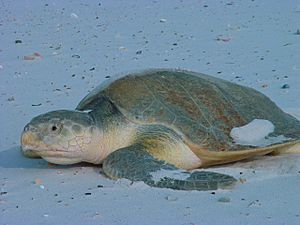Kemp's ridley sea turtle facts for kids
The Kemp's ridley sea turtle (Lepidochelys kempii) is a very special kind of sea turtle. It is also called the Atlantic ridley sea turtle. This amazing creature is the rarest type of sea turtle in the world. It is also listed as critically endangered, which means it is in great danger of disappearing forever.
The Kemp's ridley is one of only two living species in its group, called Lepidochelys. The other one is the olive ridley sea turtle.
Contents
What Does It Look Like?
The Kemp's ridley sea turtle is the smallest sea turtle in the world. Adult turtles usually have a shell (carapace) that is about 2 feet (60-70 cm) long. They weigh around 75 to 100 pounds (35-45 kg).
Their shell is a unique gray-green color. It is almost round and looks a bit flat. Young turtles are usually black on both their top and bottom shells. As they grow older, their bottom shell (plastron) turns a creamy white or yellowish color. They have strong jaws that help them crush the shells of the animals they eat.
Where Do They Live?
Kemp's ridley sea turtles mostly live in the Gulf of Mexico. They also travel into the Atlantic Ocean along the eastern coast of the United States. Young turtles often drift with ocean currents. They can be found as far north as Nova Scotia, Canada.
Adult turtles prefer warmer waters. They like shallow areas near the coast. These areas often have sandy or muddy bottoms. This is where they find their food.
What Do They Eat?
Kemp's ridley sea turtles are carnivores, which means they eat meat. Their favorite food is crabs. They use their powerful jaws to crush the hard shells of crabs.
They also eat other sea creatures. This includes snails, clams, jellyfish, and sea urchins. Sometimes, they might even eat small fish.
Life Cycle and Reproduction
Female Kemp's ridley sea turtles usually start laying eggs when they are about 10 to 15 years old. They lay their eggs on sandy beaches. The main nesting beach for this species is Rancho Nuevo in Tamaulipas, Mexico.
Nesting Habits
Unlike most other sea turtles, Kemp's ridleys often nest during the daytime. They also have a special nesting behavior called an "arribada" (Spanish for "arrival"). During an arribada, hundreds or even thousands of female turtles come ashore at the same time to lay their eggs. This usually happens between April and July.
A female turtle can lay two to three clutches of eggs in one nesting season. Each clutch has about 100 eggs. The eggs look like ping-pong balls.
Hatching and Growth
The eggs hatch after about 45 to 70 days. The time depends on the temperature of the sand. Warmer sand tends to produce more female hatchlings. Cooler sand produces more males.
Once hatched, the tiny baby turtles quickly dig their way out of the nest. They then race towards the ocean. This journey is very dangerous. Many hatchlings are eaten by birds or other animals. Those that make it to the sea will spend their early lives floating in ocean currents. They will grow bigger before returning closer to shore.
Why Are They Endangered?
The Kemp's ridley sea turtle is critically endangered. This means its population has dropped very low. There are several reasons for this:
- Fishing Gear: Many turtles get caught accidentally in fishing nets and lines. This is called "bycatch." They can drown if they can't get to the surface to breathe.
- Habitat Loss: Important nesting beaches are being lost. This happens because of coastal development and human activities.
- Pollution: Ocean pollution, like plastic bags and oil spills, harms turtles. They might mistake plastic for food or get tangled in trash.
- Climate Change: Changes in ocean temperatures and rising sea levels can affect nesting sites and food sources.
Conservation Efforts
Many people and organizations are working hard to protect Kemp's ridley sea turtles.
- Turtle Excluder Devices (TEDs): Special devices called TEDs are now required in fishing nets. These allow turtles to escape if they get caught.
- Protecting Nesting Beaches: Conservationists guard nesting beaches. They protect the eggs from predators and human disturbance.
- Raising Awareness: Educating people about the turtles helps. It teaches everyone how to protect them and their homes.
- Headstarting Programs: Some programs collect eggs, hatch them in safe places, and raise the young turtles for a short time before releasing them into the wild. This gives them a better chance of survival.
Thanks to these efforts, the number of Kemp's ridley nests has slowly started to increase. However, they still need a lot of help to fully recover.
Images for kids
See also
 In Spanish: Tortuga lora para niños
In Spanish: Tortuga lora para niños












